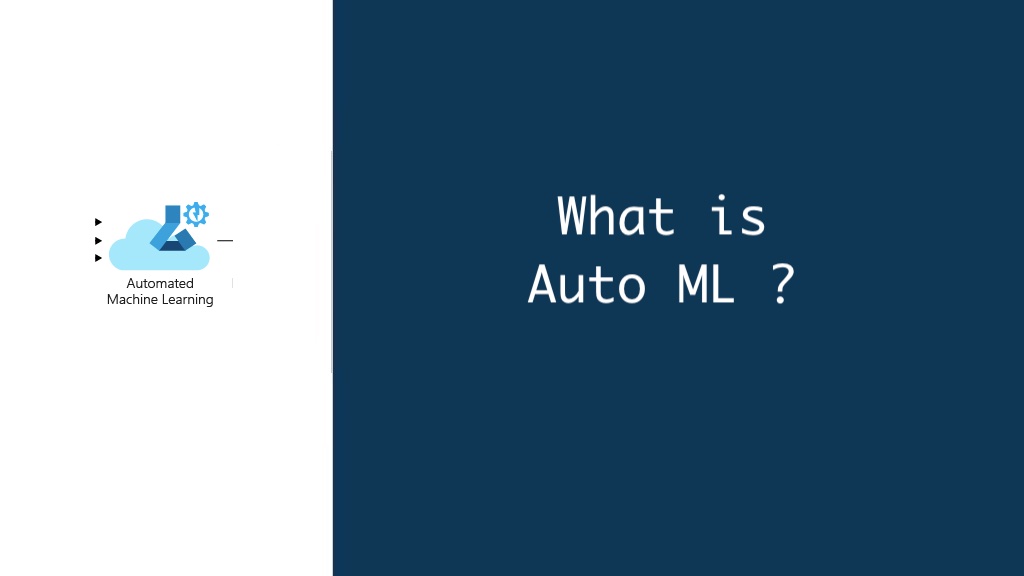Machine learning (ML) has revolutionized various fields, from healthcare to finance. However, building effective ML models traditionally requires significant expertise in data science, programming, and statistical analysis. This barrier to entry has limited the widespread adoption of ML. Enter Automated Machine Learning (AutoML), a technological game-changer that aims to democratize the field by automating the often-complex process of building and deploying ML models.
What is automated machine-learning?
It’s the process of automating machine-learning. It is the process of creating models without human intervention. Unlike manual training, automated machine-learning tasks can be completed with great efficiency. It includes all stages of the machine-learning process, including the creation of model structures. Here are the most important components in auto ML: Automation for the entire machine-learning process
AutoML: What Does it Do?
AutoML acts as an automation engine for the entire ML workflow. Traditionally, this workflow involves several steps:
- Data collection and preparation (cleaning, pre-processing)
- Feature engineering (creating new features from existing data)
- Model selection and hyperparameter tuning (finding the optimal configuration for the model)
- Model training and evaluation
- Model deployment and monitoring
AutoML automates many of these steps, allowing users with limited data science expertise to leverage the power of ML.
how AutoML streamlines the process:
- Automated Data Preparation: AutoML tools can handle data cleaning, transformation, and feature engineering tasks, often using techniques like data imputation and feature scaling.
- Intelligent Model Selection: AutoML can explore and evaluate different machine learning algorithms (e.g., decision trees, random forests), selecting the one most suited to the specific problem based on the data characteristics.
- Hyperparameter Optimization: Hyperparameters are settings that control how an ML model learns. AutoML can automatically tune these hyperparameters to optimize the model’s performance.
The Benefits of AutoML: A Boon for Data Democratization
AutoML offers several advantages that are transforming the ML landscape:
- Increased Accessibility: By automating complex tasks, AutoML empowers users with less data science expertise to build and deploy ML models. This opens doors for businesses and individuals who might not have had the resources to invest in traditional ML development.
- Improved Efficiency: AutoML streamlines the ML workflow, significantly reducing the time and resources needed to build and deploy models. This allows data scientists to focus on more strategic tasks like interpreting results and building impactful applications.
- Reduced Bias: AutoML can help mitigate bias in the ML development process by automating feature selection and hyperparameter tuning, reducing the influence of human decisions that might be subjective.
- Faster Experimentation: AutoML allows for rapid iteration and experimentation with different algorithms and hyperparameter settings, accelerating the development and deployment of ML models.
Hype: Challenges and Considerations for AutoML
While AutoML presents exciting possibilities, it’s crucial to acknowledge some challenges:
- Black Box Problem: Some AutoML tools might function as black boxes, making it difficult to understand how they arrived at specific model selections or hyperparameter configurations. This lack of transparency can be a concern for certain applications.
- Data Quality Dependence: Like any ML approach, AutoML relies heavily on high-quality data. Poor quality data can lead to suboptimal model performance, even with automation.
- Domain Expertise Still Matters: While AutoML automates many tasks, interpreting the results and ensuring the model’s relevance to the specific business problem still requires domain expertise.
- Human Expertise Still Matters: AutoML is a powerful tool, but it doesn’t replace the need for human expertise. Data scientists are still crucial for problem formulation, data understanding, and ultimately, interpreting and utilizing the results generated by AutoML models.
- Explainability and Transparency: AutoML models can be complex, making it difficult to understand how they arrive at their predictions. This lack of explainability can be a hurdle in situations requiring regulatory compliance or responsible AI practices.
Collaborative Future for AutoML and Data Scientists
AutoML is not a replacement for data scientists, but rather a powerful tool that can augment their capabilities. As AutoML continues to evolve, we can expect advancements in areas like:
- Explainable AI (XAI) Integration: Making AutoML models more interpretable to improve trust and understanding of their decision-making processes.
- AutoML for Advanced ML Techniques: Automating the use of complex deep learning architectures and techniques within the AutoML framework.
- Domain-Specific AutoML: AutoML tools tailored to specific industries or tasks can further enhance efficiency and effectiveness.
- Integration with Cloud Platforms: Cloud-based AutoML solutions with pre-built functionality and access to vast computing power will become increasingly prevalent.
The future of data science lies in collaboration between humans and AI tools like AutoML. By embracing automation for routine tasks, data scientists can free up their time for more strategic endeavors, ultimately accelerating innovation and unlocking the true potential of machine learning across various industries.
